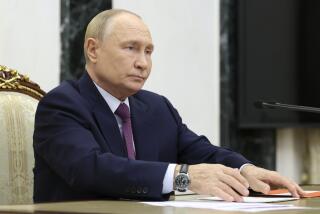U.S. Would Cut Warheads by Half if Ex-Soviets Do So
- Share via
WASHINGTON — Citing the end of “imperial communism,” President Bush offered Tuesday to cut the U.S. arsenal of nuclear warheads nearly in half if Russia and the other former Soviet republics do the same.
Bush said in his State of the Union address that he has proposed to Russian President Boris N. Yeltsin that the United States eliminate all land-based multiple-warhead missiles and cut the submarine-launched nuclear missile force by one-third if the former Soviet Union dismantles all of its land-based, multi-warhead missiles.
Bush also said he would convert a “substantial portion” of the nation’s strategic bomber fleet to deliver conventional rather than nuclear bombs.
Yeltsin’s initial reaction to the proposal has been “highly positive,” Administration officials said, but they do not expect a final answer when the two leaders meet at Camp David this weekend.
Bush also said in his address that he will cut defense spending by $50 billion over the next five years, halt the B-2 Stealth bomber program at 20 airplanes, cancel the Midgetman missile, cease purchases of advanced cruise missiles and indefinitely suspend production of all new nuclear warheads.
A senior Administration official said that the proposal “fundamentally breaks the cycle of strategic force policy over the past several decades,” in which the United States and the Soviet Union continually added to and upgraded their nuclear stockpiles.
If Yeltsin and leaders of the three other former Soviet republics that have nuclear weapons--Ukraine, Belarus and Kazakhstan--agree to the Bush proposals, both sides would be left with roughly 4,500 long-range nuclear weapons--still an awesome force but a radical reduction from historic Cold War levels.
Before the signing in 1990 of the nuclear arms cuts agreed to under the Strategic Arms Reduction Treaty and unilateral cutbacks announced last fall, the United States had 12,000 deployed nuclear weapons; the nations of the former Soviet Union had 27,000.
Bush offered a concession to Yeltsin to make the new plan more attractive. The bulk of Russia’s nuclear weapons are atop multiple-warhead missiles based on land; the heart of the U.S. nuclear deterrent is aboard Trident ballistic-missile submarines. By including about 1,300 submarine-launched weapons in the proposed reductions, Bush was offering to cut back the most fearsome weapons in the U.S. strategic arsenal.
Defense Secretary Dick Cheney had recommended the weapons cuts after consulting with the Joint Chiefs of Staff, Bush said. The cuts closely follow the results of a recent study conducted for the Strategic Air Command that said the level Bush proposed would be more than adequate to deal with any realistic threat following the collapse of the Soviet Union.
Bush’s decision to scale back or cancel several nuclear weapons programs will bring almost $18 billion in savings over the next five years, according to figures provided by the White House.
Cancellation of the B-2 bomber, which was to have carried nuclear weapons, is expected to provide most of that savings, accounting for $14.5 billion of the Pentagon’s proposed $50-billion budget reduction between 1993 and 1997, according to the White House. The 20 authorized B-2 aircraft will be reconfigured for reconnaissance or to carry conventional weapons.
Bush’s decision to discontinue development of a small, single-warhead missile known as Midgetman and to halt production of the Air Force’s cruise missile will cut $2.3 billion from the Pentagon’s five-year spending plan.
British Prime Minister John Major said that President Bush’s initiative addresses the nuclear arms problem squarely and imaginatively and said that he hoped leaders of the Commonwealth of Independent States would respond positively.
“The security of the world will be greatly enhanced if President Yeltsin agrees to the elimination of multiple-warhead intercontinental ballistic missiles, the most destabilizing elements of the old Cold War confrontation,” Major said in London.
David Wright, an arms control analyst for the Union of Concerned Scientists, said that even after Bush’s arms reductions, the United States would have nearly 5,000 long-range nuclear weapons.
“That’s still larger than the numbers of warheads you could use under any conceivable circumstances. There’s no reason he couldn’t go down to a force on the order of 1,000 warheads,” Wright said.
Times staff writer Melissa Healy contributed to this story.
More to Read
Sign up for Essential California
The most important California stories and recommendations in your inbox every morning.
You may occasionally receive promotional content from the Los Angeles Times.













